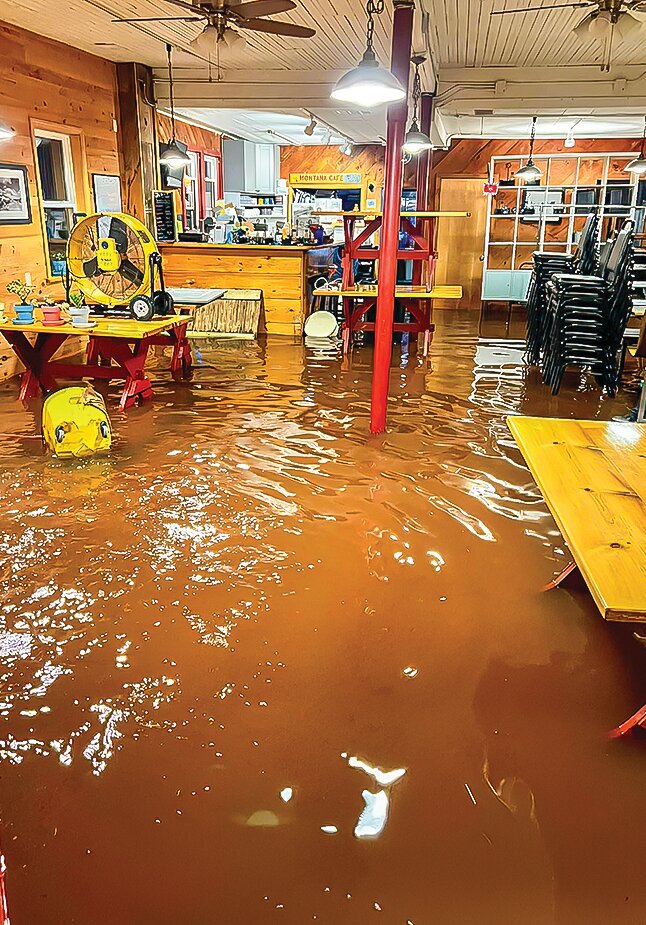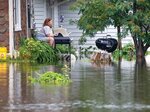Support the Timberjay by making a donation.
Flood devastates Cook
Numerous homes and businesses inundated by the rising Little Fork River
COOK- Downtown Cook and surrounding neighborhoods were overwhelmed last week by a flash flood caused by torrential rains that fell on the city and the Little Fork River drainage basin last Tuesday. …
This item is available in full to subscribers.
Attention subscribers
To continue reading, you will need to either log in to your subscriber account, below, or purchase a new subscription.
Please log in to continue |
Flood devastates Cook
Numerous homes and businesses inundated by the rising Little Fork River
COOK- Downtown Cook and surrounding neighborhoods were overwhelmed last week by a flash flood caused by torrential rains that fell on the city and the Little Fork River drainage basin last Tuesday. While floodwaters have since receded the town is facing a long and expensive period of recovery.
The impending disaster began on Tuesday with a low-pressure storm system that settled over the area and dumped intense rain across the North Country in amounts measuring up to nine inches in some areas. The deluge ravaged county roads and flooded both state highways and town streets with storm drainage systems that couldn’t keep up with the massive flows.
As runoff poured into the Little Fork River basin, the river was soon outside its banks. The water began making its way into Cook mid-morning on Wednesday.
As has been the case in past high-water incidents, portions of Vermilion Dr. were the first to flood, but this time it wasn’t long before the water began making its way farther into town.
At 9:30 a.m., a picture posted to social media showed “Cook’s lakeside library,” as 1st Ave. S in front of Cook Public Library was filled with water over its curbs.
An hour and 15 minutes later, at 10:45 a.m., the St. Louis County Sheriff’s Office got the first report of flooding in Cook, according to undersheriff Jason Akerson. At the time the Emergency Management team was in Biwabik assessing washouts and river blockages. After being notified of the situation, they headed to Cook.
After they arrived, Emergency Operations Manager Josh Brinkman met with city staff and assessed the situation. According to Akerson, “it was apparent that the quick onset of floodwater would make it impossible to sandbag in time to protect property. Mayor Harold Johnston confirmed that decision on Friday.
“We didn’t have the time to do it,” he said. “It takes first of all sandbags, and it takes lots of people to fill them. And we have a lot of sandbagging to do if we’re going to protect the whole city. So that was not done. And our county emergency management guy, Josh (Brinkman), supported us on that decision.”
Meanwhile, the floodwaters kept rising as flood watchers used the disappearing legs of the moose statue in front of the city’s library as an unofficial flood gauge. By early afternoon, there was significant flooding occurring on River St., with numerous downtown businesses reporting floodwaters entering their stores. There were isolated attempts at sandbagging to stave off the waters.
Lois Pajari at Cook’s Country Connection initiated a sandbagging effort using a sand pit at her farm and many volunteers responded, as there was significant demand and need.
A flood inundation report from the Duluth NWS office issued at 5:42 p.m. indicated the Little Fork River would continue to rise through at least Saturday morning before starting to recede.
Another marker of the spread of the flood came at about 10 p.m. when Memory Malone, who lives at 128 2nd St. SE, across the street from the Northern Comfort Company, put out a plea on social media for sandbags, as the flood waters had reached her house. At about the same time, Pajari posted that, “As far as we have heard, all that needed sandbags have them,” and indicated there were sandbags available at the community center, the Country Store, and the fire hall.
On Thursday morning, Joe Paakkonen delivered a dump truck load of sand to the Country Store for a sandbagging site. Additional sites at the community center and the fire hall were operating during the day.
It was also the morning the city of Cook issued it’s first of what would be daily information releases providing important information about the flood response. That and subsequent releases were posted to the city’s website, and since the city does not have a social media page the releases were shared on the Facebook pages of Cook Public Library and city council member Liza Root. They were also emailed to area media outlets for posting on websites and social media.
Thursday’s report noted that city operations had been moved from city hall to the community center, announced that Trinity Lutheran Church would serve as an evacuation site, said that floodwater was backing up through the storm water system, and discouraged travel in areas where flooding was present, stating that the waters were “dangerous and posed health and safety risks.” No specific mention was made that due to the flooding the city’s wastewater disposal system had been overwhelmed and that sewage was combined with the flood waters.
Also on Thursday, the Red Cross provided a disaster relief unit that was stationed at the community center. The St. Louis County Rescue Squad provided door-to-door assessments of residences in the flooded area. City officials, staff, and area rescue organizations met to plan action steps as the flooding continued.
Water continued rising throughout the day, posing a possible threat to the Cook VFW building, which had been sandbagged. It was reported that the depth of the water in Franks Pharmacy reached four feet, while water rose nearly a foot above the stage at the Comet Theater.
Early Friday morning multiple pictures posted to social media appeared to indicate that the flood had peaked ahead of the Saturday prediction, and that was confirmed throughout the morning, as the waters retreated from the intersection of River St. and 2nd Ave. SE to just south of the library. The dry street allowed barricades to be moved later in the morning to allow closer access for a motorcade carrying Gov. Tim Walz, numerous state officials connected with emergency response, and area legislators. Walz met with local residents and business owners, toured the flooded area in a St. Louis County Rescue Squad amphibious vehicle, and provided information and assurance about state and federal flood relief funding.
Activities throughout town shifted to the slow and tedious process of recovery in the ensuing days. Firefighters used their equipment to pump water out of many homes and businesses, and people began pulling up carpet and flooring and moving affected furniture and appliances to curbsides and numerous roll-off dumpsters deployed around town.
An organized volunteer effort kicked off on Saturday at the Cook Fire Hall, with volunteers coming from towns across the Iron Range, and the city held public meetings on Saturday and Sunday at the hall to provide information on relief services that were available and important safety information for cleanup. The city council also met following Saturday’s meeting to approve a disaster declaration that will be formalized at this Thursday’s council meeting.
Flood relief fundraising got a boost when the Cook Lions Club announced on Saturday that they would serve as the recipient for donations through an account at North Star Credit Union and kicked off the effort with a $10,000 donation from Lions Clubs International. A fundraiser dinner conducted by the Lake Vermilion Fire Brigade on Saturday evening collected over $15,000 for relief efforts.
On Monday and Tuesday, Lions Club volunteers put the relief funds to good use by caravaning to Virginia to get cleaning supplies, protective gear, dehumidifiers, power washers, shop vacs and more for free distribution at the fire hall. L&M Supply and Menard’s supported the effort with donations and discounts. Meanwhile, volunteer crews could be seen throughout town with trucks and trailers, picking up sandbags and appliances, and city streets were declared free of water on Tuesday.













